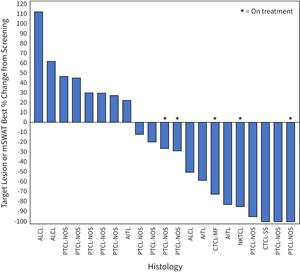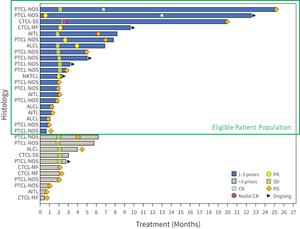Corvus Pharmaceuticals Presents New Interim Soquelitinib Data from its Phase 1/1b T Cell Lymphoma Trial
Anti-tumor activity and durability of responses data support advancement of soquelitinib (formerly known as CPI-818) into Phase 3 registrational clinical trial and its potential to address the need for new treatments for peripheral T cell lymphoma (PTCL)
Results confirmed patient eligibility requirements and endpoints planned for soquelitinib Phase 3 clinical trial in PTCL
“We have continued to enroll patients in the soquelitinib Phase 1/1b clinical trial to further confirm the eligibility requirements and design for our planned Phase 3 clinical trial,” said
New Soquelitinib Interim Data from the Phase 1/1b Clinical Trial
Updated interim data as of
- For the eligible patient population, objective responses (complete response, CR plus partial response, PR) were seen in 7 of 21 patients with disease control (CR, PR and stable disease) in 12 of 21 patients. The stable disease group included 5 patients who achieved tumor reductions that did not meet the criteria for a PR, with two of these patients continuing on therapy.
- For the eligible patient population, the median duration of response (DOR) for the seven patients with objective response by Lugano criteria was 14.5+ months (ranged from 6.9-25.2 months); three of these patients continued on therapy.
- A total of five patients in the eligible patient population remained on therapy, including one patient with a CR at 21+ months, two patients with a PR at 3+ and 8+ months, and 2 with stable disease at 3+ and 5+ months.
Kaplan Meier estimated median progression free survival was 6 months for the eligible patient population.Kaplan Meier estimated overall survival at 2 years was 77% for all 36 patients.- One additional eligible patient, not shown here, was treated at a higher dose and achieved a PR. While in PR, this patient went on to receive a bone marrow transplant and achieved a CR, which has continued as of the data cutoff without any further therapy for 2+ years.
- For the ineligible patient population, no objective responses were seen in 11 evaluable patients.
Figure 1: Waterfall Plot for Patients in the 200 mg Dose Cohort of the Soquelitinib Phase 1/1b Clinical Trial for Peripheral T Cell Lymphoma. The plot shows the best percent change in tumor volume in the 21 evaluable patients (eligible patient population) that were measurable by CT scan or by mSWAT for patients with cutaneous involvement.
Figure 2: Swimmer Plot of Eligible Patient Population (N=21 evaluable, blue) and Ineligible Patient Population (N=11 evaluable, gray). Tumor histologies are also shown. Eligible or ineligible designates whether a patient would qualify for the phase 3 clinical trial.
Figure 3: Table Comparing Soquelitinib Data from Phase 1 (Eligible and Ineligible) to Data Reported for Pralatrexate and Belinostat. Pralatrexate and belinostat received accelerated approval for relapsed PTCL and will be utilized in the standard of care arm of the planned soquelitinib Phase 3 trial. Soquelitinib data are shown for both the eligible and ineligible patient populations from the Phase 1/1b trial reported above. Patient characteristics such as age, number of prior therapies and response to most recent prior therapies for the eligible patient population are similar to those reported for pralatrexate and belinostat. Progression free survival is the primary endpoint for the planned Phase 3 clinical trial; objective response rate and survival are secondary endpoints. The ORR, disease control rate, PFS and OS presented below were not derived from a head-to-head study and are for informational purposes only. Differences exist between trial designs, subject characteristics and other factors, and caution should be exercised when comparing data across unrelated studies.
| Soquelitinib (Phase 1) | Belinostat (BELIEF)1 (N=129) |
Pralatrexate (PROPEL)2 (N=111) |
||
| Phase 3 Eligible ≥1 to ≤ 3 therapies (N=21) |
Phase 3 Ineligible > 3 therapies (N=11) |
|||
| Age (median) | 60 yrs. | 65 yrs. | 64 yrs. | 58 yrs. |
| Prior Therapies (median) | 2 | 6 | 2 | 3 |
| Response to most recent prior therapy | 39.1% | 23.1% | 41.6% | 36.7% |
| Objective Response Rate | 33.3% | 0% | 25.8% | 29% |
| Disease Control Rate | 57.1% | 45.5% | 40.8% | 48% |
| Progression Free Survival (median) | 6 months | 2.3 months | 1.6 months | 3.5 months |
| Overall Survival at 24 months3 | 77% | ~30% | ~35% | |
| 1 O’Connor O. et. al. |
||||
| 2 O’Connor O. et. al. |
||||
| 3 Includes all 36 enrolled patients | ||||
Molecular Studies on Patient Tumors Support Soquelitinib’s Novel Mechanism of Action
Additional new interim data from the Phase 1/1b clinical trial of soquelitinib will be presented today
- Responding patients (N=2) showed a sustained increase in CD4+ Th1 cells in the blood and an increase in CD8+ TEMRA cells (T effector memory cells). TEMRA cells are T cells that have responded to an antigen and are able to mediate effector functions, such as the destruction of tumor cells.
- Patients with stable disease (N=4) showed increases in these cell populations that were transient.
- Patients who progress (N=3) showed no increase in these cells.
- Single cell RNA sequencing of tumor biopsies showed soquelitinib treatment increased expression of cytolytic effector molecules and led to a reduction of T cell exhaustion markers.
The ASH poster is available to ASH attendees in the poster hall and via the virtual event platform, and is also available on the Publications and Presentations page of the Corvus website.
About Corvus Pharmaceuticals
Corvus Pharmaceuticals is a clinical-stage biopharmaceutical company pioneering the development of ITK inhibition as a new approach to immunotherapy for a broad range of cancer and immune diseases. The Company’s lead product candidate is soquelitinib, an investigational, oral, small molecule drug that selectively inhibits ITK. Corvus plans to initiate a Phase 3 registrational clinical trial for soquelitinib in patients with relapsed peripheral T cell lymphoma. Its other clinical-stage candidates are being developed for a variety of cancer indications. For more information, visit www.corvuspharma.com.
About Soquelitinib
Soquelitinib (formerly known as CPI-818) is an investigational small molecule drug given orally designed to selectively inhibit ITK (interleukin-2-inducible T cell kinase), an enzyme that is expressed predominantly in T cells and plays a role in T cell and natural killer (NK) cell immune function. The immunologic effects of soquelitinib lead to what is known as Th1 skewing and is made possible by the high selectivity of soquelitinib for ITK. Research on soquelitinib’s mechanism of action suggests that it has the potential to control differentiation of normal T helper cells and enhance immune responses to tumors by augmenting the generation of cytotoxic killer T cells and the production of cytokines that inhibit cancer cell survival. Soquelitinib has also been shown to prevent T cell exhaustion, a major limitation of current immunotherapy and CAR-T therapies. Optimal doses of soquelitinib have been shown to affect T cell differentiation and induce the generation of Th1 helper cells while blocking the development of both Th2 and Th17 cells and production of their secreted cytokines. Th1 T cells are required for immunity to tumors, viral infections and other infectious diseases. Th2 and Th17 helper T cells are involved in the pathogenesis of many autoimmune and allergic diseases. The Company believes the inhibition of specific molecular targets in T cells may be of therapeutic benefit for patients with cancers, including solid tumors, and in patients with autoimmune and allergic diseases. Based on interim results from a Phase 1/1b clinical trial in patients with refractory T cell lymphomas, which demonstrated tumor responses in very advanced, refractory, difficult to treat T cell malignancies, the Company plans to initiate a registrational Phase 3 clinical trial of soquelitinib in patients with relapsed PTCL.
Forward-Looking Statements
This press release contains forward-looking statements, including statements related to the potential safety and efficacy of the Company’s product candidates including soquelitinib, ciforadenant and mupadolimab; the potential use of soquelitinib to treat a variety of solid tumors and hematological cancers; the Company’s ability and its partners’ ability, as well as the timing thereof, to develop and advance product candidates into and successfully complete preclinical studies and clinical trials, including the Company’s Phase 1/1b clinical trial of soquelitinib; and the timing of and the Company’s ability to launch clinical trials including the potential registrational Phase 3 clinical trial for soquelitinib. All statements other than statements of historical fact contained in this press release are forward-looking statements. These statements often include words such as “believe,” “expect,” “anticipate,” “intend,” “plan,” “estimate,” “seek,” “will,” “may” or similar expressions. Forward-looking statements are subject to a number of risks and uncertainties, many of which involve factors or circumstances that are beyond the Company’s control. The Company’s actual results could differ materially from those stated or implied in forward-looking statements due to a number of factors, including but not limited to, risks detailed in the Company’s Quarterly Report on Form 10-Q for the three months ended September 30, 2023, filed with the Securities and Exchange Commission on
INVESTOR CONTACT:
Chief Financial Officer
+1-650-900-4522
llea@corvuspharma.com
MEDIA CONTACT:
Real Chemistry
+1-949-903-4750
sseapy@realchemistry.com
Photos accompanying this announcement are available at
https://www.globenewswire.com/NewsRoom/AttachmentNg/f50c7d0a-0631-445b-bdfd-6b4e11ce9e1a
https://www.globenewswire.com/NewsRoom/AttachmentNg/8ed7ee4c-7450-4ed0-a4a3-051d8ed5b3f8

Figure 1: Waterfall Plot for Patients in the 200 mg Dose Cohort of the Soquelitinib Phase 1/1b Clinical Trial for Peripheral T Cell Lymphoma.
The plot shows the best percent change in tumor volume in the 21 evaluable patients (eligible patient population) that were measurable by CT scan or by mSWAT for patients with cutaneous involvement.
Figure 2: Swimmer Plot of Eligible Patient Population (N=21 evaluable, blue) and Ineligible Patient Population (N=11 evaluable, gray).
Tumor histologies are also shown. Eligible or ineligible designates whether a patient would qualify for the phase 3 clinical trial.
Source: Corvus Pharmaceuticals, Inc.



